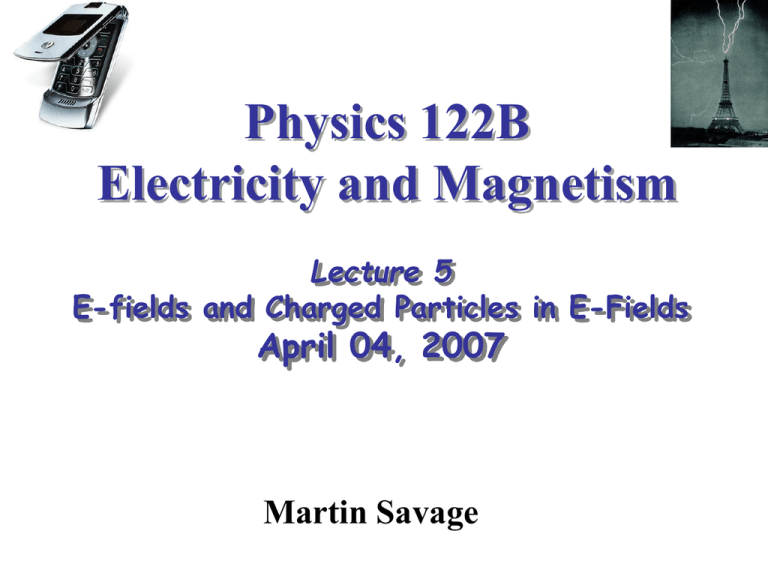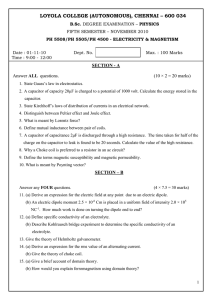Physics 122B Electricity and Magnetism Martin Savage April 04, 2007
advertisement

Physics 122B Electricity and Magnetism Lecture 5 E-fields and Charged Particles in E-Fields April 04, 2007 Martin Savage Lecture 5 Announcements Lecture Homework #1 have been posted on the Tycho system. It is due at 10 PM tonight. E-Field of a Charged Sphere Therefore, the electric field outside the surface of a uniformly spherically charged shell of charge Q with radius R is: Esphere 1 Q rˆ 2 4 0 r (independent of R) In other words, it has the same E-field as that produced by a point charge Q located at the center of the sphere. If h=Q/4R2 is the surface charge density, then the surface E field is Esurf=h/0, i.e., twice as big as the E field of an infinite plane of charge. (Why?) The electric field inside the spherical-shell is zero (because the sum of the forces cancel). 7/19/2016 Physics 122B - Lecture 5 3 Example: A Charged Sphere A sphere with a radius R = 0.1 m has a charge Q = 20.0 nC on its surface. What is the electric field at a distance of 1.0 m from the sphere? Esphere 1 Q 4 0 r 2 (9.0 109 N m 2 /C 2 )(2.0 10-8 C)/(1.0 m) 2 1.8 102 N/C Note that the electric field does not depend on the radius of the sphere (because the E-field of a charged sphere is the same as that of the same charge at a point at the center of the sphere.) Measuring the external E-field tells you the charge but not the radius of the sphere. 7/19/2016 Physics 122B - Lecture 5 4 A Parallel-Plate Capacitor The parallel plate capacitor is an important component of electronic circuits. It is constructed of two oppositely charged electrodes separated by a small gap. The net charge of the capacitor is zero. We can model the parallel plate capacitor as two parallel infinite charged planes placed a distance d apart. Let the x axis go from + to -. Then we have only to superpose the fields that we have previously calculated. We find that in the two regions outside the gap the superposed fields cancel to give 0, while in the gap they add. Therefore: Eoutside E E iˆh / 2 0 iˆh / 2 0 0 Egap E E 2iˆh / 2 0 iˆh / 0 h Q / A , so E capacitor iˆ 7/19/2016 Q 0 A Physics 122B - Lecture 5 5 Capacitor Edge Effects Since the electrodes of a real parallel plate capacitor are not infinite, there are “edge effects” at the ends of the electrodes. 7/19/2016 Physics 122B - Lecture 5 6 Example: A Parallel-Plate Capacitor The parallel plate capacitor consists of two circular electrodes of radius R=0.1 m separated by a gap of d=1 mm, with opposite charges of magnitude Q=20 nC on the two electrodes. What is the electric field between the plates? Ecapacitor Q 0 A A R2 R 1 0 Ecapacitor (2.0 10-8 C) 4 (9.0 10 N m /C ) (0.1 m) 2 9 2 2 7.2 104 N/C (Notice that the electric field does not depend on the gap d.) 7/19/2016 Physics 122B - Lecture 5 7 Motion of a Charged Particle in an Electric Field Fon q qE a Fon q q E m m qE If E is uniform, then a constant m In an electric field, does a charged particle follow the field lines? NO! Only a massless charged particle would follow the field lines. 7/19/2016 Physics 122B - Lecture 5 8 Example: An electron moving across a capacitor Two 6.0 cm diameter circular electrodes are spaced 5.0 mm apart. They are charged by transferring 1.0 x 1011 electrons from one electrode to the other. A electron is released from rest at the surface of the negative electrode. How long does it take the electron to cross to the positive electrode? Assume the space between the electrodes is a vacuum. E h Q Ne 0 0 A 0 R 2 x d 12 a(t )2 4(9.0 109 Nm 2 /C 2 )(1.0 1011 )(1.6 1019 C) /(0.03 m) 2 6.39 105 N/C eE (1.6 1019 C)(6.39 105 N/C) a 1.12 1017 m/s 2 -31 m (9.1110 kg) 7/19/2016 Physics 122B - Lecture 5 2d 2(5.0 103 m) t a (1.12 1017 m/s 2 ) 2.98 1010 s V/c = a t/c ~ 0.1 9 Example: Deflecting an electron beam An “electron gun” creates a beam of electrons moving horizontally with a speed vx = 3.34 x 107 m/s. The electrons enter a 2.0 cm long gap between two parallel electrodes producing a downward electric field of E = 5.0x104 N/C. In what direction and by what angle is the electron beam deflected? (Neglect fringing) eE (1.6 1019 C)(5.0 104 N/C) 15 2 ay 8.78 10 m/s m (9.1110-31 kg) t L / vx (0.02 m) /(3.34 107 m/s) 5.99 10-10 s vy ay t (8.78 1015 m/s2 )(5.99 10-10 s) 5.26 106 m/s (5.26 106 m/s) Arctan Arctan 8.95 7 vx (3.34 10 m/s) vy 7/19/2016 Physics 122B - Lecture 5 The deflection is upward because the negatively charged electron experiences a force in the opposite direction from E. 10 Motion in a Nonuniform Field The motion of a charged particle in a non-uniform field can be quite complicated. However, one case is easy to analyze: the circular orbit of a charged particle around another point charge, a charged sphere, or a long straight charged wire (so that the field at some distance r is constant). In such cases, mv 2 Fnet qE r Example – An electron in a hydrogen atom orbits at a radius of r=0.053 nm. What is the orbital velocity of the electron? qE 2 1 e mv 4 0 r 2 r 7/19/2016 2 ve 1 1 4 0 mr (1.6 10 -19 (9.0 109 N m 2 /C 2 ) 6 C) 2.18 10 m/s -31 -11 (9.1110 kg)(5.3 10 m) Physics 122B - Lecture 5 11 Question 1 Which field is responsible for the trajectory of the proton as shown? 7/19/2016 Physics 122B - Lecture 5 12 Dipole in a Uniform Field Consider a permanent electric dipole of dipole moment p=qs in a uniform external electric field E. F qE F qE Fnet F F 0 p p If the axis of the dipole is not aligned with the field (a), the dipole will experience a torque. If the dipole is aligned with the field (b) it will not experience a torque, and it is in stable equilibrium. In either case, there is no net force on the dipole. When dipoles, e.g., water molecules, are placed in an external field, they will tend to align with the field as shown, so that p||E. 7/19/2016 Physics 122B - Lecture 5 13 Torque on a Dipole in a Uniform Field If the axis of the dipole is not aligned with the field, the dipole will experience a torque . The dipole moment is: p qs where s goes from - q to q F ( s sin )(qE ) pE sin p E 7/19/2016 Physics 122B - Lecture 5 14 Example: Angular acceleration of a dipole dumbbell Two 1.0 g spheres are connected by a 2.0 cm long insulating rod of negligible mass. The spheres have equal and opposite charges of 10 nC. The rod is held in a uniform field of E = 1.0x104 N/C at an angle of 300 to the field, as shown, then released. What is the angular acceleration a of the system? p qs (1.0 10-8 C)(0.02 m) 2.0 10-10 C m. pE sin (2.0 10-10 C m)(1.0 104 N/C )sin 30 1.0 10-6 N m I 2m(s / 2)2 2(0.001 kg)(0.01 m)2 2.0 10-7 kg m2 a / I (1.0 10-6 N m) /(2.0 10-7 kg m2 ) 5.0 rad/s 2 7/19/2016 Physics 122B - Lecture 5 15 Dipole in a Nonuniform Field F qE F qE Fnet F F 0 if E E In the non-uniform field of a point charge, the dipole will first align with the field (p||E) and then be attracted by it. The net force on the dipole will be attractive, independent of whether the field is from a negative or a positive point charge. In general, a dipole will experience a net force toward any charged object. 7/19/2016 Physics 122B - Lecture 5 16 Example: The force on a water molecule The water molecule H2O has a permanent dipole moment of p = 6.2x10-30 C m. A water molecule is located 10 nm from a Na+ ion in a salt water solution. What force does the ion exert on the water molecule? Edipole 1 2p 4 0 r 3 Trick: Calculate force on Na ion from dipole field. Fdipole on ion eEdipole 1 2ep 4 0 r 3 2(1.6 10-19 C)(6.2 10-30 C m) (9.0 10 N m /C ) (1.0 10-8 m)3 9 2 2 1.79 1014 N Fion on dipole Fdipole on ion 1.79 1014 N 7/19/2016 Physics 122B - Lecture 5 17 End of Lecture 5 Before the next lecture on Wednesday, read Knight, Chapters 27.2 through 27.4 Lecture Homework #1 should be submitted on the Tycho system by tonight at 10 PM .



